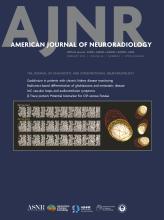Jump to comment:
- Page navigation anchor for RE: Reply in response to “Regarding “The ‘Outline Sign’: Thin Hyperenhancing Perimeter as an MR Imaging Feature of Meningioma. A Useful Tool in the Temporal Bone Region for Differentiating Meningiomas from Schwannomas and Paragangliomas””RE: Reply in response to “Regarding “The ‘Outline Sign’: Thin Hyperenhancing Perimeter as an MR Imaging Feature of Meningioma. A Useful Tool in the Temporal Bone Region for Differentiating Meningiomas from Schwannomas and Paragangliomas””
We would like to thank the letter authors for their interest in our article and the opportunity to clarify methodologic aspects that were raised as concerns.
First, we agree that timing of contrast administration is important to consider in all imaging studies. With this in mind, all MRI studies in our cohort were performed where acquisition of post-contrast images occurred within the immediate time period following injection of IV contrast, and the first sequence obtained following contrast injection was the axial spin echo T1-weighted sequence. The imaging protocol has remained consistently the same during the time period in which the MRI examinations in our cohort were performed. As such, any heterogeneity would presumably be random (in addition to being agnostic to tumor type), and any bias arising from heterogeneity of contrast timing would therefore bias the results toward the null. In other words, it would underestimate the effect observed. We are confident that the Outline Sign we observed and compared with various tumor types are not a result of contrast timing differences, rather they are a result of the tumor type.
Second, the letter authors raise concern about the use of meningiomas elsewhere. This study is about observation of the Outline Sign in meningiomas. We have observed this sign in meningiomas in locations supratentorially and in the posterior fossa. As can be seen with our data, it was indeed not the case that unless the Outline Sign was...
Show MoreCompeting Interests: None declared. - Page navigation anchor for Regarding "The “Outline Sign”: Thin Hyperenhancing Perimeter as an MR Imaging Feature of Meningioma. A Useful Tool in the Temporal Bone Region for Differentiating Meningiomas from Schwannomas and Paragangliomas"Regarding "The “Outline Sign”: Thin Hyperenhancing Perimeter as an MR Imaging Feature of Meningioma. A Useful Tool in the Temporal Bone Region for Differentiating Meningiomas from Schwannomas and Paragangliomas"
We read with great interest the article by Vasireddi et al., "The “Outline Sign”: Thin Hyperenhancing Perimeter as an MR Imaging Feature of Meningioma. A Useful Tool in the Temporal Bone Region for Differentiating Meningiomas from Schwannomas and Paragangliomas", which investigates the utility of the "Outline Sign" for distinguishing meningiomas from schwannomas and paragangliomas in the temporal bone region. Indeed, this is a valuable effort addressing a relevant and frequent diagnostic challenge in neuroradiology. With the aim of boosting the value of this interesting article even more, we would like to raise some methodological aspects and suggest additional considerations regarding the final conclusions.
First, we stress the potential impact of variability in the timing between contrast administration and image acquisition, which the authors did not account for in their methodology, something that could potentially and significantly influence the depiction of the "Outline Sign." Delayed imaging after contrast administration, for instance, may exaggerate or diminish peripheral enhancement due to differences in contrast perfusion and diffusion dynamics.[1,2] This raises an important question: could the observed "Outline Sign" be influenced, at least in part, by inconsistencies in the imaging protocols rather than being an intrinsic tumour characteristic? Addressing this issue through stand...
Show MoreCompeting Interests: None declared.












